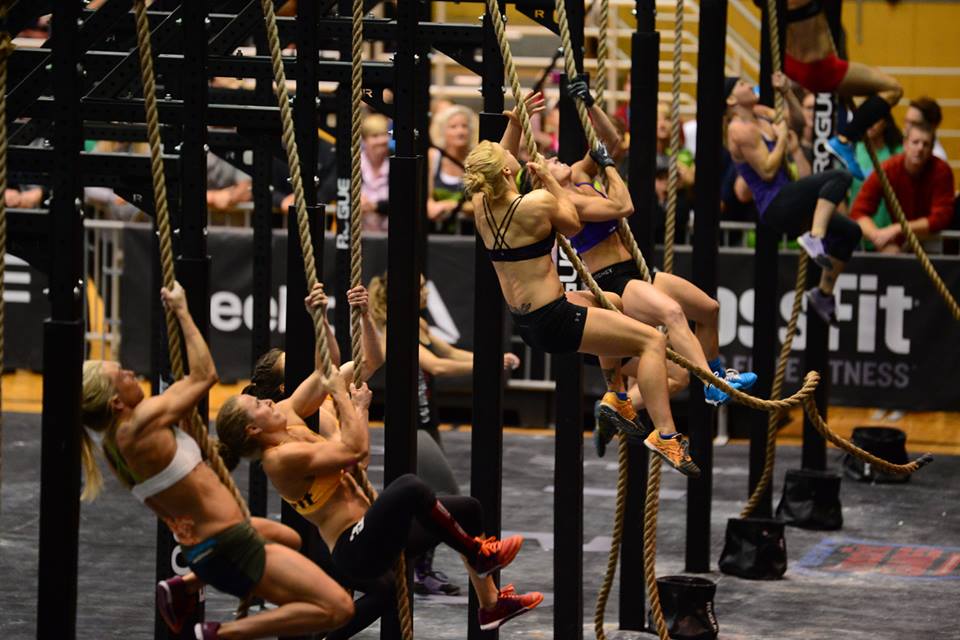Written by Chad Wesley Smith Pictured, Team Juggernaut athlete Jamie Hagiya of Torrance CrossFit. Jamie finished 5th at SoCal Regionals. Note: Those of you who argue about CrossFit’s legitimacy as a sport or its safety, stop it, just stop. CrossFit has one governing body, a real World Championship (the Games), a real qualifying process (The Open and Regionals), real prize money/media coverage (to the powerlifters and strongmen who say they don’t want or care about this for their sport…you’re an idiot). All of those traits are things that powerlifting/strongman desperately need. To the “it’s dangerous” crowd, first lets distinguish that I’m talking about the sport of CrossFit-not people who train day to day for general fitness with CrossFit . Sports done at high levels are dangerous and the competitors choose to deal with that risk. Powerlifting isn’t healthy, strongman isn’t healthy, running marathons isn’t healthy, playing in the NFL isn’t healthy and getting punched in the face for a living in the UFC ain’t healthy, neither is CrossFit, who cares, it’s a competition.
There has been a lot of talk recently from well known coaches about how competitive CrossFit athletes don’t train by doing CrossFit, that they need to put specific time towards specific tasks and developing specific skills.
This statement is true and guess what the most specific skill a CrossFit competitor needs to excel in is…not powerlifting, not weightlifting, not distance running/rowing/swimming/hiking, not gymnastics but CrossFit, the unique, unpredictable, soul crushing combination of all the above. The most important skill a CrossFit athlete needs to train is doing CrossFit!! The best CrossFitter is the one who is best at doing CrossFit, not the strongest one, the most gymnasty one, the one with the best mile time, it is the CrossFittest one.
Now what does it mean to be the CrossFittest? In my opinion it is the person who combines strength, skill, aerobic capacity, lactic capacity, mental toughness, durability and strategy in relatively balanced proportions.
Everyone who begins competing in CrossFit comes in with a unique athletic background and accompanying set of physical qualities, these athletes exist within a spectrum of to the far right the highest level of explosive strength and power qualities (ie. Olympic weightlifter, 100m sprinter) and to the far left, athletes with the highest aerobic qualities (marathon runner, triathletes).
The person who excels in CrossFit will fall towards the middle of this spectrum, possibly slightly to the right. You don’t get bonus points for snatching 350 if 2nd place is 300 pounds, nor do you get bonus points for lapping the field during a 5k, you just need to win.
CrossFit though is not so cut and dry as various tests of diverse singular qualities, like a snatch max or 5k. Those may exist sure, but undoubtedly there will be workouts that combine multiple skills, multiple energy systems and in that way are specifically CrossFit.

Powerlifters (hopefully) understand that if you want to squat more, you squat more, if you want to bench more, you bench more, if you want to pull more, you pull more. This same idea holds true for CrossFitters, if you want to CrossFit better, you CrossFit more. Now what exactly that means, if a bit more broad but for the most part it means that you need to train specifically for CrossFit and that means doing a broad variety of tasks at low/medium intensity for varying durations, fast, and doing that a lot.
The idea that CrossFit competitors should compartmentalize their training into a variety of specialties in lieu of training traditional CrossFit style workouts, is just wrong, so stop saying it. Is there a place for directed training in the snatch, clean & jerk, squat, deadlift, gymnastics and aerobic capacity? Of course, but they can not be trained in a vaccum to maximize success.
The idea that CrossFit competitors should direct the majority of their training towards strength development because conditioning only takes a short time to develop is also wrong, so stop saying it. Conditioning (though still sub par) for football can be developed in a few weeks, if you think that this is also true for CrossFit then you don’t watch CrossFit. Conditioning for a workout, sure, conditioning for a day of workouts, maybe if you’re inclined towards it already, conditioning for a weekend of workouts, not a chance in hell.
Conditioning for CrossFit is a unique quality, you will not find it in books by Bompa or Siff or Veroshansky, it is a unique hodge-podge of energy system work that can only be trained for in 1 specific way, by doing CrossFit. Great alactic capacity alone will fail you, yet it is a key trait, great aerobic capacity alone will fail you, yet it is a key trait, great lactic capacity alone will fail you, yet it is a key trait. All of these qualities must be trained, separately and together, via a variety of means.
Training for competitive CrossFit is a complex and challenging undertaking and is one of my favorites as a coach-obviously not an athlete because I mean 100 reps of something, f&@# that! In regards to training specificity, I would suggest you think of the sport as a dart board, it isn’t about hitting a few bull’s-eyes it’s about evenly covering the board as well as possible, and the more quality training you do, the more darts you get to throw. So if you want to improve as a CrossFit athlete, then train specifically, by doing more CrossFit.
Related Articles:






